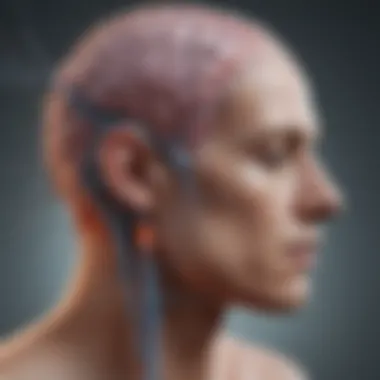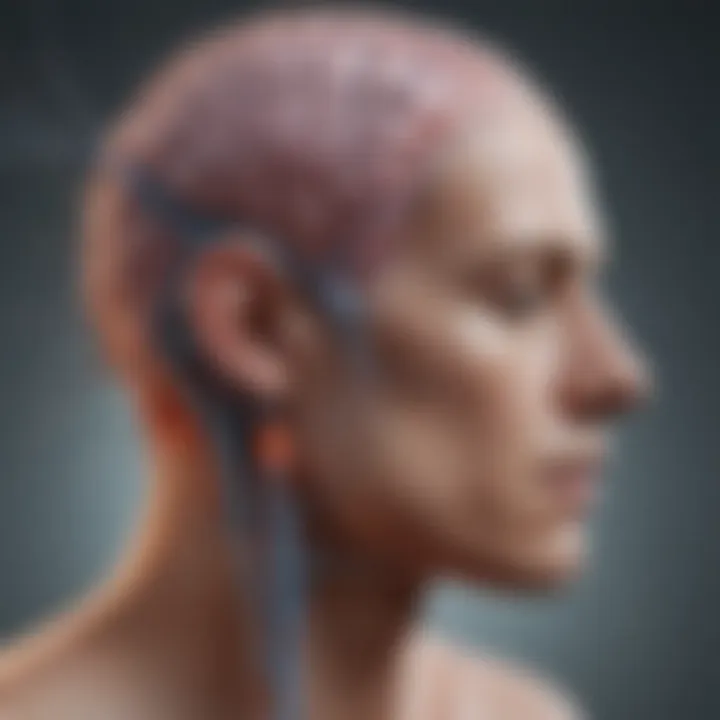Migraines and Puberty: An In-Depth Exploration


Intro
Understanding the connection between migraines and puberty is crucial due to the significant changes experienced during this developmental stage. Migraines, a common neurological condition, can be exacerbated by the physiological shifts that occur when adolescents enter puberty. This intersection can have lasting impacts on an adolescent’s quality of life, education, and mental health. Exploring this topic reveals how hormonal variations, shifts in brain chemistry, and social factors intertwine to influence migraine experiences among young individuals.
Overview of Research Topic
Brief Background and Context
Puberty marks a transformative period in human development. Hormonal changes, particularly fluctuations in estrogen and progesterone, are known to impact various bodily functions, including pain perception. Migraines, characterized by intense headache episodes often accompanied by nausea and sensitivity to light, affect a significant number of adolescents. Studies indicate that the onset of puberty may increase both the frequency and intensity of migraines in this age group.
Importance in Current Scientific Landscape
Research on the connection between puberty and migraines remains relatively sparse, despite its critical implications. Understanding this relationship is essential for tailoring prevention and treatment strategies specific to adolescents. By focusing on the hormonal and neurological changes during puberty, healthcare providers can enhance their approach to managing migraines in young patients, which is particularly important given the potential psychosocial consequences of untreated migraine attacks.
Methodology
Research Design and Approach
Investigating the relationship between migraines and puberty employs a multi-faceted approach. Both qualitative and quantitative research designs play a role in this exploration. Quantitative studies often involve longitudinal data collection, which tracks migraine occurrences among adolescents over a defined period. In contrast, qualitative studies may use interviews or focus groups to gather personal accounts from adolescents experiencing migraines, thus adding depth to the statistical data.
Data Collection Techniques
Data collection techniques vary based on the research design. Surveys and headache diaries are commonly used to quantify migraine frequency, duration, and severity. Additionally, biological samples, such as hormonal assays, can provide insight into the endocrinological aspects contributing to migraine patterns.
By utilizing comprehensive methodologies, researchers can form a more complete picture of how puberty affects migraines, helping to inform future studies and clinical practices.
Prolusion to Migraines and Puberty
The relationship between migraines and puberty is a nuanced subject that merits thorough exploration. Puberty represents a significant developmental phase, marked by a host of physiological, hormonal, and neurological changes. These transitions can profoundly impact the frequency and severity of migraines in adolescents. Understanding this connection is imperative, not just for clinical recognition but for the overall well-being of young individuals navigating this complex life stage.
In this section, we will highlight key aspects of both migraines and puberty. Recognizing the symptoms, triggers, and treatment options offers essential insights for healthcare providers, educators, and families. This awareness can lead to timely interventions, fostering a supportive environment for adolescents facing these challenging conditions.
Defining Migraines
Migraines are neurological disorders characterized by intense, debilitating headache episodes. The pain often occurs on one side of the head and is typically accompanied by other symptoms such as nausea, vomiting, and sensitivity to light and sound. The International Classification of Headache Disorders outlines specific criteria for diagnosis, helping in the accurate identification of this condition.
Research indicates that the age of onset for migraines often coincides with puberty, particularly in females. Hormonal changes, notably the fluctuations of estrogen, may play a crucial role in the onset and exacerbation of migraine episodes. Understanding these aspects is vital for both awareness and management of migraines in this demographic.
Understanding Puberty
Puberty is a phase of significant physical, emotional, and cognitive maturation. It usually occurs between ages 10 and 14 for girls and slightly later for boys. Hormonal orchestrations trigger changes in the body, affecting growth, development, and psychological aspects.
During puberty, individuals experience not only physical growth but also emotional and social changes. These shifts can create an environment of stress and anxiety, influencing overall health, including susceptibility to migraines. The interplay between these factors reinforces the need to understand puberty's broader implications on adolescent health generally and, specifically, on migraine prevalence.
"Understanding the intricate links between puberty and migraines can enhance diagnostic accuracy and treatment efficacy."
Grasping the definitions of migraines and puberty sets the stage for deeper exploration of their intersection. In subsequent sections, we will delve into epidemiology, physiological changes, and the psychosocial impacts, ultimately striving to provide meaningful insights into the challenges faced by adolescents experiencing migraines.
Epidemiology of Migraines in Adolescents
Understanding the epidemiology of migraines in adolescents is crucial for multiple reasons. First, it offers insight into how common migraines are in this demographic. Knowing the prevalence helps healthcare providers recognize and address migraine-related issues more effectively. Additionally, examining epidemiological data reveals patterns that can inform treatment plans. It highlights specific populations that may be more at risk and helps identify potential underlying causes related to the developmental stage of puberty.
In the context of this article, shedding light on the epidemiology of migraines among adolescents contributes to a broader understanding of the interplay between physiological changes and migraine occurrence. The information aids in fostering awareness among teachers, parents, and healthcare providers about the significance of recognizing migraines in this age group.
Prevalence Rates
Studies indicate that migraines are notably prevalent in adolescents. Research shows that approximately 10-20% of adolescents experience migraines, which is significant. These figures underscore the importance of recognizing migraines as a common health issue in young individuals. It's not just an occasional headache; it can severely impact daily life, including academic performance and social interactions.
Moreover, many adolescents may not report their symptoms. Misdiagnosis or underreporting often occurs in this age group, leading to a lack of appropriate care. This reality emphasizes the need for better educational resources and awareness programs for both adolescents and adults involved in their lives.
Gender Disparities
Research on gender sparsity in migraine prevalence during adolescence shows a marked difference. Studies indicate that girls are more likely to suffer from migraines than boys by nearly two to three times. This disparity becomes more pronounced during and after puberty, suggesting that hormonal changes may play a role in the increased incidence among females.


The reasons behind this discrepancy can include:
- Hormonal Fluctuations: The onset of menstruation and changing estrogen levels can trigger migraines.
- Psychosocial Factors: Different societal expectations and stressors can impact girls and boys differently as they navigate adolescence.
- Genetics: Family history may play a role in gender-based prevalence.
Understanding these gender disparities is essential for developing targeted prevention and treatment strategies that consider these unique risks and experiences.
In summary, examining the epidemiology of migraines in adolescents not only sheds light on prevalence and gender disparities but also lays the groundwork for future research and intervention efforts.
Physiological Changes During Puberty
Puberty represents a critical transitional phase in human development. It is during this time that adolescents undergo significant physiological changes which can influence their overall health and particularly, their experiences with migraines. Understanding these transformations is essential for comprehending the increased frequency and severity of migraines observed in this demographic.
Hormonal fluctuations play a pivotal role during puberty. Both estrogen and testosterone surge during this period, leading to alterations in the vascular and neurological systems. These changes can impact how the body responds to pain, thereby influencing migraine susceptibility. As the endocrine system matures, it can become more reactive, potentially creating an environment conducive to headache disorders.
Another factor to consider is the developmental changes in the brain. The adolescent brain undergoes significant remodeling, affecting not just cognitive functions but also emotional regulation and pain perception.
"Understanding how physiological changes during puberty relate to migraines is crucial for developing effective management strategies."
This period of development is not merely a biological shift but carries numerous implications. Adolescents may experience variations in headache patterns due to these physiological transformations. Recognizing and addressing these aspects is vital for healthcare providers and educators to support affected individuals effectively.
Hormonal Influences
Hormones are pivotal in the regulation of migraine attacks. Adolescents experience increased levels of estrogen as they enter puberty, which directly correlates with the onset of migraines in females. Estrogen levels can fluctuate dramatically during the menstrual cycle, and this variability can trigger migraine episodes. Research suggests that migraine prevalence may peak around the onset of menstruation, when estrogen levels are on the decline. Understanding these dynamics can lead to targeted treatments.
Conversely, testosterone also plays a role, though the relationship is less pronounced than with estrogen. In general, males are less likely to report migraines than females, especially pre-puberty. However, the role of testosterone and its interactions with other hormones during puberty require more exploration. Studying these influences can help elucidate gender disparities in migraine prevalence.
Neurological Development
During puberty, significant neurological changes occur. The brain undergoes maturation with the refinement of neural connections. This process can affect pain pathways and potentially alter sensitivity to triggers associated with migraines. Adolescents might find that their bodies respond differently to stimuli, both physical and emotional. Stress particularly becomes a major factor, noted to exacerbate migraine occurrences. When combined with the various emotional and psychological pressures of adolescence, this uptick in stress can lead to an increased incidence of migraines.
Another noteworthy point is the potential for cognitive changes. As reasoning and critical thinking skills develop, adolescents may become more aware of their physical responses and pain. This heightened awareness can influence not only how they experience their migraines but also how willing they are to seek treatment or change their lifestyle to mitigate triggers.
The interrelationship between hormonal and neurological changes during puberty is intricate and demands careful consideration when approaching treatment options for migraines in this population. By fostering a nuanced understanding of these physiological changes, healthcare professionals can better address the challenges faced by young individuals dealing with migraines.
The Link Between Hormones and Migraines
Understanding the link between hormones and migraines is pivotal in ascertaining how hormonal fluctuations during puberty influence migraine prevalence. The adolescent period signifies a time of profound hormonal changes. These changes can exacerbate the intensity and frequency of migraine attacks. Recognition of this phenomenon is essential for developing effective treatment strategies that cater specifically to adolescents.
Hormonal imbalances may serve as catalysts for various physiological responses. Particularly, in the context of migraines, the surge of hormones such as estrogen and testosterone can influence the pain pathways and neurotransmitter systems involved in migraine pathophysiology. Addressing these hormonal aspects provides insights into how migraines may differ in adolescents compared to other age groups.
Estrogen and Migraine Pathophysiology
The role of estrogen in migraine has been extensively studied. Estrogen affects the central nervous system and contributes to various signaling pathways. This hormone can alter the thresholds for headache, reducing the brain's resilience to triggering factors. Women are observed to report more migraines than men, particularly during their menstrual cycles, when estrogen levels fluctuate drastically.
During puberty, females experience an increase in estrogen production, which correlates with the onset of migraine symptoms. Such fluctuations can lead to a heightened susceptibility to migraines during specific life stages. Understanding how estrogen modulates pain pathways can clarify why interventions targeting hormonal balance may prevent or minimize the frequency of migraines.
Key points regarding estrogen and migraines include:
- Increased Susceptibility: The rising levels of estrogen in adolescents can increase the likelihood of migraine attacks.
- Migraine Patterns: Patterns often align with menstrual cycles, illustrating a strong hormonal connection.
- Target for Treatment: Hormonal regulation may hold potential as a treatment strategy for young females suffering from migraines.
"The fluctuation of estrogen during adolescence plays a significant role in the onset of migraines among young females."
Testosterone's Role
While estrogen’s impact on migraines is more documented, testosterone also warrants discussion. This hormone plays a notable role in the male adolescent population's experience with migraines. It is hypothesized that testosterone influences pain receptors and neurological pathways, possibly mitigating the intensity of migraine attacks.
Nevertheless, the relationship between testosterone levels and migraine frequency needs further exploration. Some studies suggest that an increase in testosterone might offer a degree of protection against migraines in males. Understanding this hormonal nuance is critical, as treatment approaches could benefit from considering individual hormonal profiles.
Important points regarding testosterone and migraines include:
- Less Frequent Attacks: Male adolescents often report fewer migraine occurrences compared to females during puberty.
- Hormonal Modulation: Testosterone may have a protective effect that warrants further research.
- Individual Treatment Plans: Tailoring treatment plans according to the hormonal milieu could enhance migraine management strategies.
Psychosocial Impact of Migraines During Puberty


The significance of understanding the psychosocial impact of migraines during puberty cannot be overstated. This developmental stage is characterized by numerous changes in both physical and emotional aspects of adolescents. The onset of migraines in this period often amplifies the existing turbulence of teenage life. By examining how these headaches influence the emotional and social dimensions of adolescents, we can develop a clearer picture of the overall implications on their quality of life.
Quality of Life Considerations
Migraines can severely affect the quality of life of adolescents. They often lead to missed school days and decreased participation in social activities. Many teenagers face chronic pain which can interfere with their academic performance. This is particularly concerning considering the fast-paced learning environment typical of puberty. The challenges induced by migraines can cause frustration, anxiety, and depression.
Research indicates that adolescents with migraines experience a lower quality of life when compared to their peers without such conditions. They may also report increased levels of stress and general dissatisfaction with life. Important aspects that are impacted by migraines include:
- Physical health: Frequent headaches can lead to fatigue and sleep disturbances.
- Emotional well-being: Adolescents may feel isolated or misunderstood due to their condition.
- Social engagement: Attending events and hanging out with friends may become challenging.
Impact on Social Interactions
The relational dynamics of adolescents are often fragile. When migraines come into play, these interactions can be further complicated. Adolescents may withdraw from social situations to avoid potential migraines, diminishing their social circles. This isolation can lead to feelings of loneliness and exacerbate mental health issues like anxiety.
Moreover, the perception of peers towards adolescents suffering from migraines can also play a role. Misunderstandings about the condition may lead to stigma. Other teens might not grasp the severity of migraines, resulting in unsupportive attitudes.
The interplay between such factors further deepens the need for supportive environments. Schools and families can play an intricate role in helping adolescents navigate their relationships amid these challenges. Awareness of migraines among peers can create a more understanding social atmosphere, reducing stigma and assisting those affected in maintaining their social lives.
"The care provided by friends and family during migraine episodes can mitigate feelings of isolation that many adolescents endure."
Recognizing the psychosocial impact of migraines during puberty is crucial. It aids in ensuring that adolescents not only manage their migraines effectively but also maintain their emotional health and social connections.
Common Triggers of Migraines in Adolescents
Understanding common triggers for migraines among adolescents is essential for grasping the broader relationship between migraines and puberty. During this developmental phase, various factors can significantly influence migraine frequency and intensity. Identifying these triggers can help in managing symptoms more effectively, thus improving the quality of life for affected individuals. Furthermore, awareness of these triggers equips parents, educators, and healthcare providers with knowledge that can support early intervention and prevention strategies.
Dietary Influences
Dietary factors can play a pivotal role in triggering migraines in adolescents. Researchers have identified certain foods and beverages that may increase the likelihood of migraine attacks. Common culprits include aged cheeses, processed meats, and products containing caffeine or artificial sweeteners. Furthermore, skipping meals or prolonged fasting may also contribute to migraine occurrences.
Maintaining a balanced diet is crucial not only for general health but also for minimizing migraine triggers. Here are some dietary considerations:
- Hydration: Staying adequately hydrated is vital. Dehydration can be a prominent trigger and should not be overlooked.
- Regular Meals: Eating regular, nutritious meals helps stabilize blood sugar levels. Fluctuations can lead to headaches and migraines.
- Food Diary: Keeping a food diary may help identify problematic foods. Patients can track what they eat and correlate it with migraine episodes.
Adolescents, especially those undergoing hormonal changes during puberty, may find it beneficial to have guidance from healthcare professionals regarding diet and its implications for migraine management.
Stress and Emotional Factors
Stress has long been recognized as a significant trigger for migraines, especially in adolescents. The demands of school, social life, and familial pressure can create an environment prone to stress. This stress can lead to increased tension, which often manifests as migraine headaches.
Moreover, emotional states such as anxiety and depression are common during puberty and have been linked to the onset of migraines. Adolescents can feel overwhelmed by their changing bodies and social dynamics. Here are key emotional factors that can influence migraines:
- High-Pressure Situations: Exams or significant life transitions often lead to acute stress. Finding coping strategies could help mitigate this.
- Social Challenges: Difficulties in peer relationships may lead to prolonged emotional distress, which can trigger migraines.
- Mindfulness Practices: Techniques such as yoga and meditation may assist in reducing stress levels.
Understanding these triggers can empower adolescents and their supporters to take proactive measures in managing migraines effectively.
By taking dietary influences and stress factors into account, individuals can better navigate the complexities of migraines through adolescence. Awareness is a critical first step towards effective management and improving overall well-being.
Diagnosis of Migraines in Adolescents
Diagnosing migraines in adolescents is crucial for several reasons. First, accurate diagnosis allows for appropriate treatment, minimizing the impact on the adolescent's daily life. Moreover, understanding migraine patterns can help healthcare providers personalize interventions. The adolescent phase presents unique challenges in terms of both psychological and physiological development, making proper diagnosis even more essential. Misdiagnosis or delayed diagnosis can lead to unnecessary suffering and impaired quality of life.
Clinical Guidelines
Clinical guidelines for diagnosing migraines in adolescents involve a thorough patient history, physical examination, and relevant diagnostic criteria. The International Classification of Headache Disorders (ICHD) serves as a key reference. For an adolescent, clinicians typically look for:
- Duration and Frequency: Migraines are often characterized by attacks lasting from 4 to 72 hours.
- Symptoms: The presence of nausea, vomiting, photophobia, or phonophobia often indicates migraine.
- History of Episodes: A documented history of recurrent headaches is also important for diagnosis.
Additionally, tools such as the Pediatric Migraine Disability Assessment (PedMIDAS) can help evaluate the impact of migraines on an adolescent’s daily functioning. These guidelines ensure that practitioners effectively recognize and manage migraines among young patients.
Differential Diagnosis
Differential diagnosis is an essential aspect of migraine assessment in adolescents. Several other conditions could mimic migraine symptoms, leading to potential mismanagement:


- Tension-Type Headaches: Often presents as a pressing tightness rather than throbbing pain.
- Cluster Headaches: Characterized by severe unilateral pain, usually around the eye.
- Medication Overuse Headaches: Result from excessive use of pain relief medication, potentially masking underlying migraine conditions.
- Neurological Disorders: Conditions like seizures may require distinct management approaches and should be ruled out.
A comprehensive examination of medical history, along with imaging studies if necessary, can clarify these related conditions. The goal is to avoid inappropriate treatments while ensuring that adolescents receive the care they truly need.
Treatment Approaches for Adolescent Migraines
Adolescents experiencing migraines face unique challenges that significantly affect their day-to-day lives. Therefore, understanding the effective treatment approaches is crucial. Treatments designed specifically for this age group can help manage pain, reduce the frequency of attacks, and improve overall quality of life. A tailored approach is necessary to address the distinct physiological and psychological aspects inherent in adolescents. These treatments generally fall into two categories: pharmacological and non-pharmacological interventions.
Pharmacological Treatments
Pharmacological treatments for migraines in adolescents require careful consideration. These treatments typically include preventive and acute therapies.
- Preventive Medications:
- Acute Treatments:
- Medications like topiramate and amitriptyline are often prescribed. They aim to reduce the frequency and severity of migraine attacks.
- These medications might take several weeks to see their full effect.
- For immediate relief during a migraine attack, drugs such as ibuprofen or triptans are utilized.
- Triptans like sumatriptan are specifically designed to treat headaches and may provide significant relief within hours of use.
It is important for healthcare providers to discuss potential side effects with patients. Some medications can cause sedation or gastrointestinal distress. Awareness of these aspects helps in tailoring the right treatment plan that minimizes risks while maximizing effectiveness.
Non-Pharmacological Interventions
Non-pharmacological interventions can also play a critical role in managing migraines among adolescents. These approaches often serve as complementary strategies alongside medication. They can produce lasting benefits and fewer side effects.
- Cognitive Behavioral Therapy (CBT):
- Lifestyle Modifications:
- Biofeedback:
- Acupuncture:
- CBT helps adolescents develop coping strategies for stress, which can be a significant trigger for migraines.
- By addressing emotional and behavioral components, CBT empowers adolescents to take control of their health.
- Encouraging regular sleep patterns, proper hydration, and balanced nutrition can reduce the likelihood of migraine occurrences.
- Additionally, activities like yoga or regular physical exercise can relieve stress and subsequently lessen migraine frequency.
- This technique teaches individuals to control physiological processes by providing real-time feedback. Through biofeedback, adolescents can learn to relax and potentially decrease the intensity of their migraines.
- Some studies suggest acupuncture may help relieve migraines without the side effects sometimes associated with medications. It’s important to consider this as an adjunct option.
Overall, the integration of both pharmacological and non-pharmacological treatments provides a comprehensive approach to managing migraines in adolescents. The right balance is essential in maximizing outcomes and improving the quality of life for those affected.
"A multi-modal approach highlights the importance of addressing both biological and psychological dimensions in migraine treatment."
In this context, understanding the efficacy and potential risks associated with each treatment modality is vital. Providing personalized care that considers the individual needs of adolescents will foster better management of migraines during this crucial developmental stage.
Future Research Directions
Research in the intersection of migraines and puberty holds significant potential for advancements in understanding and treatment strategies. These studies can unveil critical insights into how hormonal fluctuations impact migraine pathophysiology in adolescents. Increased scrutiny on this developmental phase may reveal new biological markers, paving the way for targeted interventions.
Longitudinal Studies
Longitudinal studies are paramount in assessing the long-term impact of puberty on migraine patterns. These studies track adolescents over time, capturing the onset of migraines in correlation with various stages of puberty. By following individuals across critical developmental milestones, researchers can identify how migraine frequency and severity shift. Moreover, understanding triggers during these transitions is essential. The data gathered allows for a robust evaluation of preventive strategies tailored to individual risk factors tied to their unique hormonal changes.
Intervention Studies in Diverse Populations
Diverse populations offer a rich ground for intervention studies, providing insight into how cultural, environmental, and genetic factors influence migraines during puberty. Such studies can help establish if certain treatments are universally effective or if variations are needed according to demographic characteristics. For instance, specific dietary or lifestyle interventions can be examined across different ethnic groups to discern their efficacy in alleviating migraines. By involving a wide range of demographic groups, researchers can develop comprehensive guidelines that are inclusive and effective for everyone suffering from adolescent migraines.
Through understanding these various elements of adolescent migraine research, we can create a pathway toward more effective and personalized treatment options for this vulnerable population.
Ending
Understanding the relationship between migraines and puberty is essential for both clinicians and patients. The complexity of how hormonal changes during puberty can lead to variations in migraine prevalence and severity cannot be overstated. Additionally, recognizing the implications of these conditions can help in identifying appropriate strategies to manage and treat adolescent migraines effectively.
Summarizing Key Insights
Adolescents face unique challenges regarding migraines. Key insights from this article include:
- Hormonal Influence: Fluctuations in estrogen and testosterone can contribute to the onset and exacerbation of migraines during puberty.
- Psychosocial Factors: Migraines can significantly impact the quality of life, affecting social interactions and emotional well-being in adolescents.
- Diverse Treatment Approaches: Various treatment modalities, including pharmacological and non-pharmacological options, need to be tailored to adolescents' specific needs.
The dynamics of both physiological and psychological aspects must be considered in treatment plans. While the direct link between puberty and migraines requires further investigation, current research suggests that improving awareness can lead to better targeting of interventions.
The Importance of Awareness
Awareness of the potential for migraines during puberty is essential for all stakeholders—parents, educators, and healthcare professionals. By recognizing the signs and symptoms associated with migraines, they can facilitate early diagnosis and appropriate treatment. This proactive approach can lessen the impact on the adolescent's daily activities and relationships.
Furthermore, raising awareness can help reduce stigma around migraine conditions, promoting open dialogue about the challenges faced by adolescents. Understanding that migraines are not mere headaches can foster better support systems, which are crucial during this formative stage.



